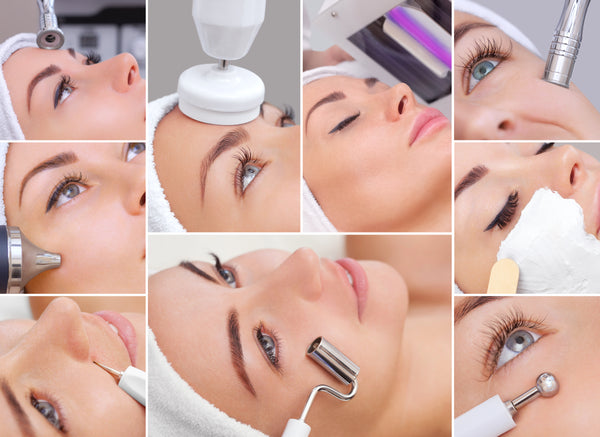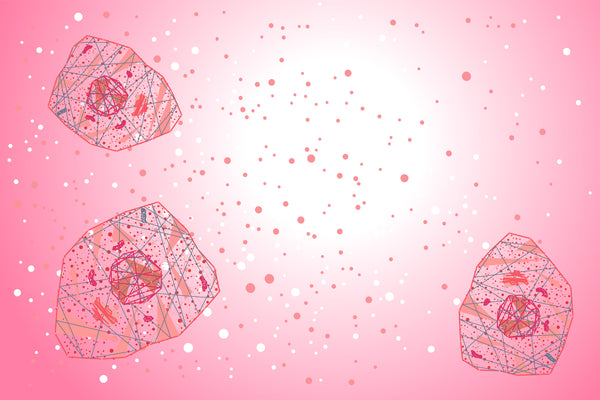
Although medspas originally became popular with the use of injectables along with skin care treatments, they are also known today for the machines that can be used for a variety of conditions including fat reduction, skin tightening, resurfacing and skin tone. The following are some of the frequently used machines in the medspa for their respective targets.
Resurfacing
Hydradermabrasion. Microdermabrasion came into the market in the late 90s and has been a popular skin rejuvenation procedure since. However, the latest trend in medspas is the use of hydradermabrasion machines. Many of these machines have the same benefi ts of traditional microdermabrasion but with the added advantage of infusing product into the skin simultaneously.
Hydradermabrasion devices typically have a rough tip to achieve physical exfoliation; some examples are diamond-tip, nylon brush bristles and spiralized plastic tips. During exfoliation, a serum is fl owing through the tip of the handpiece, allowing for greater product absorption. Each manufacturer has their own formulations, and most have a variety of infusion products that can be customized for common skin conditions. Hydradermabrasion is most commonly used to improve skin tone and texture. The treatment can be performed as often as every week, but most clients receive the treatment once a month.
Fractionated resurfacing lasers. There are numerous types of lasers available in esthetics. The light energy produced by lasers is directed to specific targets or chromophores, which are chemical groups capable of selective light absorption. Common chromophores for esthetic laser treatments are melanin for hyperpigmentation and hair reduction, oxyhemoglobin for vascular lesions, ink for tattoo removal and water for resurfacing. Once the light is absorbed by the target, it triggers a reaction. Some of the more popular laser treatments are fractionated resurfacing lasers and pico lasers.
-

Pico lasers are commonly used for tattoo removal and melasma reduction.
-
The first fractional laser was introduced in 2004, and many others soon followed. Traditional resurfacing lasers produced great results, but it left clients with anywhere from ten days to eight weeks of downtime and a heightened chance of side effects. Fractional lasers use energy to either heat-up (non-ablative) or remove (ablative) portions of skin with a beam of light through a diffractionated microlens. The idea is to leave areas of untouched skin for the growth of new, healthy tissue. The ability to leave small portions of intact skin behind results in rapid re-epithelialization, fewer complications, and more consistent results. Each technology has its own unique properties, including the size and shape of the microthermal zones created, as well as different treatment protocols. Fractional lasers, in general, have proven effects on skin texture, tone and tightening.
Radio frequency microneedling. Newer machines in the medspa combine modalities for more dramatic results, including radio frequency and microneedling. There are several of these devices available each with varying features and benefits, but ultimately the radio frequency energy is delivered through the needles that penetrate the skin. The energy creates heat to stimulate more collagen resulting in firmer, smoother skin. One of the main differences in these machines is the type of needles used. There are insulated and non-insulated needles. Insulated needles deliver the energy through the tip of the needle, whereas non-insulated deliver energy throughout the whole needle. There are varying opinions as to which is better, but the insulated needles have a lower chance of complications on darker skin types. The treatment works best on texture and tightening. Since radio frequency is color blind, opposed to lasers that seek out color, it is safe for all Fitzpatrick types with little concern of post-inflammatory hyperpigmentation. Most manufacturers recommend three treatments spaced four to six weeks apart.
Fat Reduction
Cryolipolysis. Cryolipolysis is a fat reduction procedure that offers an alternative to surgery with no downtime. CoolSculpting is designed to take inches off the body in the hard-to-lose areas such as the stomach, lower back, thighs, flanks, upper arms and under the chin. This treatment is not intended for weight-loss, but for those who have an area or areas of stubborn fat that exercise or dieting won’t help.
The machine utilizes a handpiece that is placed methodically to the area of stubborn fat and left on for 30 minutes. The fat is slowly sucked up into the applicator where it is brought down to a freezing temperature. The client feels a cold sensation, but most say it is only slightly uncomfortable. The goal is to damage the fat cells through intense cold and then allow the body to do the rest. When the machine finishes a cycle, the fat cells are frozen and begin to die before they are naturally eliminated from the body. That is not to say someone can’t gain weight again following the procedure. It is recommended to follow a healthy eating and workout plan. The visual effects take place in as little as three weeks, but improvement continues up to six months. Although most patients are happy after one treatment, some may need multiple treatments on one area to get the best results.
Electromagnetic energy. One of the newest machines available on the market for body contouring is EmSculpt. This machine utilizes high intensity focused electromagnetic energy to stimulate muscles and tighten the skin. Each treatment of 30 minutes creates 20,000 muscle contractions. It can be used currently to build the muscles and burn fat on the buttocks and stomach, and eventually, it will have indications for the thighs and arms. Patients are recommended to come twice a week for two weeks for a total of four treatments. During the treatment, the patient will feel strong vibrations through the applicator that is placed on the targeted area(s). There is no pain, but some patients feel a little sore for a couple of days following the procedure, like an intense workout. The best candidates are those that have a healthy body mass index that want more tone and definition. EmSculpt is the first machine of its kind that works on building the muscles, rather than destroying fat cells or skin tightening like many of the others.

Cryolipolysis is designed to remove stubborn fat from hard-to-lose areas.
Skin Tightening
Radio frequency. Radio frequency treatments are most commonly used for patients whose main concerns are sagging skin, fine lines and premature aging. Radio frequency devices emit energy in the form of electromagnetic waves that convert to heat. These waves heat the dermis to stimulate collagen production, resulting in skin tightening. The function of radio frequency is to deliver just enough energy to create a wound-healing response without creating a wound. The heat denatures damaged proteins and promotes collagen remodeling. Radio frequency energy is delivered to heat the water content of skin to the ideal temperature, which is between 104°F to 115°F, depending on specific protocols. The degree of skin tightening is progressive and subtle. Although skin tightening may appear immediately post-treatment, that is typically due to inflammation. True results usually take four to six weeks to start and can continue anywhere from three months up to a year. The number of treatments needed varies depending on the device and treatment indications. Radio frequency devices are also used for body contouring and vaginal rejuvenation. For body contouring, the premise is the heat will destroy the fat and subsequently tighten the skin. When radio frequency is used for vaginal rejuvenation, it works to heat up the vaginal walls to tighten along with other benefits including heightened sexual pleasure and reduction in urinary incontinence.
Micro-focused ultrasound. The use of micro-focused ultrasound was introduced in 2009 to deliver heat to deep, subdermal connective tissue in focused zones. The treatment is approved by the U.S. Food and Drug Administration (FDA) to lift the skin on the neck, chin and brow.
The mechanical energy produced from the sound waves bypass the epidermis and papillary layer of the dermis, producing small microthermal lesions deep in the reticular layer of the dermis and the hypodermis. Another unique feature of micro-focused ultrasound is that it uses the imaging benefits of ultrasound technology to ensure correct focal points in each client. Therefore, the esthetic provider can see precisely where the energy will be positioned. This treatment has made its mark in the skin-tightening world rather quickly. The downside is that many experience pain throughout the procedure, but the results seem to make it worth it.
Skin Tone
Intense pulsed light (IPL). IPL targets multiple wavelengths in the visible light and infrared spectrum, as opposed to lasers that are directed at one specific wavelength. IPL is commonly called photo-rejuvenation since the multiple wavelengths of light can target various chromophores with a single setting. IPL is most commonly used to reduce hyperpigmentation, diminish red blood vessels and subsequently improve the appearance of the skin.
Radio frequency is commonly used to treat sagging, aging skin. skin quickly with no down time. IPL can also stimulate collagen with the heat it produces, although consensus opinion insists that longer wavelengths and resurfacing lasers are more effective for this indication. Other conditions treated with IPL include hair reduction, sun damage, flushing associated with rosacea, poikiloderma (characterized by vascular lesions and red or brown pigmentation), acne and telangiectasia. IPL can be performed on the face, décolleté, arms, hands and back. A series of three to five treatments spaced three to four weeks apart is commonly recommended.
Pico lasers
Pico lasers have become more commonly used due to the increase in the tattoo removal business. Pico lasers utilize fast pulses of light to mechanically break down ink, pigment and damaged proteins. Pico lasers deliver energy at trillionths of a second allowing for the skin to cool quickly to reduce the possibility of creating heat damage. Fast-pulsed lasers are often used for tattoo removal; tattoos have dense pigment that can absorb heat easily and lead to burns. Using a fast pulse width reduces the chance of complications since the light is used to mechanically break up the tattoos rather than heating it up. Pico lasers have also shown great benefit for those with melasma, using the same idea as tattoo ink. Melasma is dense pigment that could easily absorb heat and damage surrounding skin with longer pulse widths. Some pico lasers are fractionated, which make them good for textural concerns including acne scarring and wrinkles.

Radio frequency is commonly used to treat sagging, aging skin.
Be Knowledgeable
Advancements in technology will continue to increase the use of machines in medspas. In the future, I think we will see more machines with combined modalities and an increase in devices for body contouring. It is important for estheticians to keep up to date on the machines commonly used as well as new advancements in the industry. Clients are savvy these days and are looking to you for advice.

Note: treatments that a licensed esthetician may perform in a medical spa space vary by state. Please consult with your state board before adopting or performing any unfamiliar treatment.




0 comments